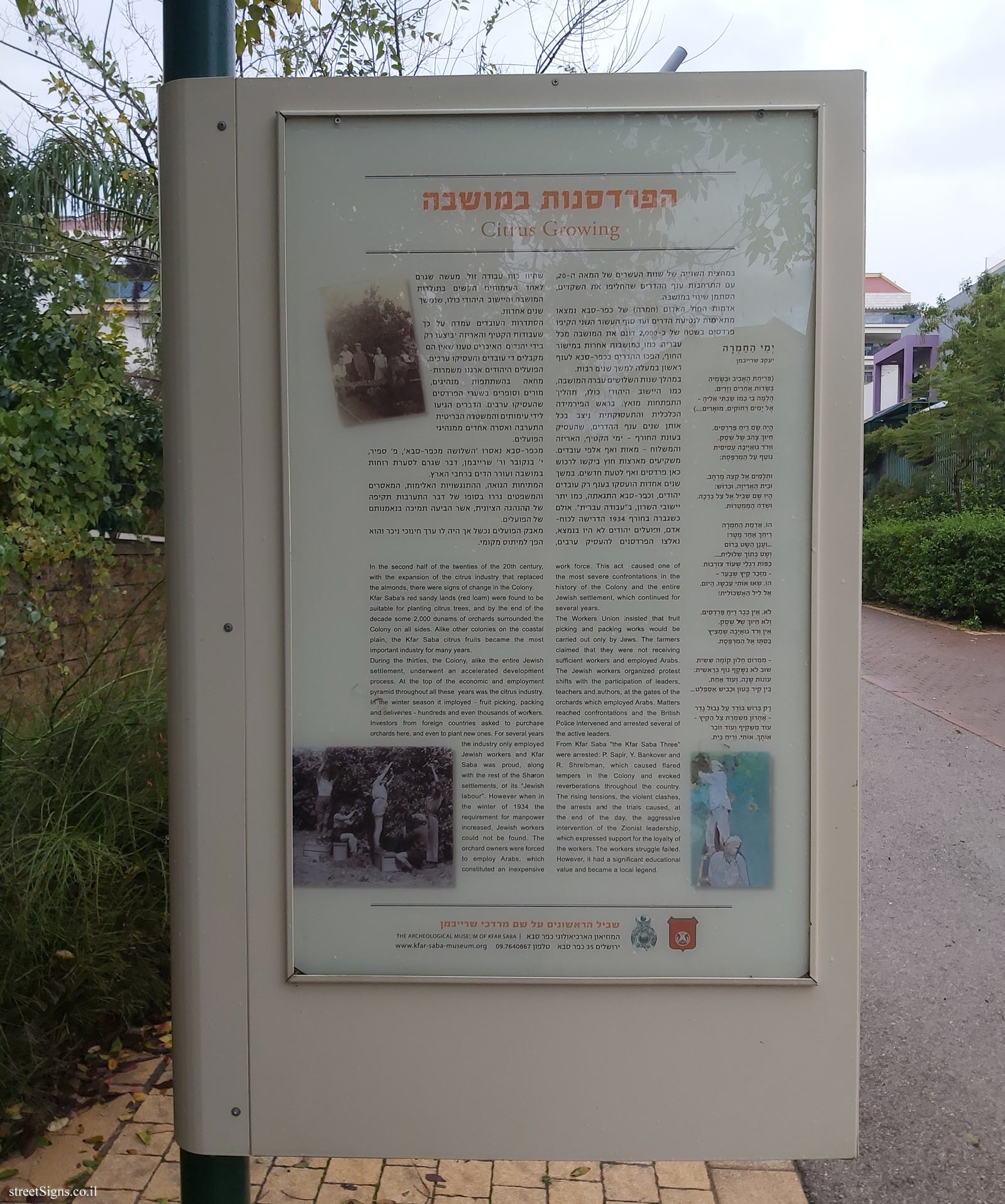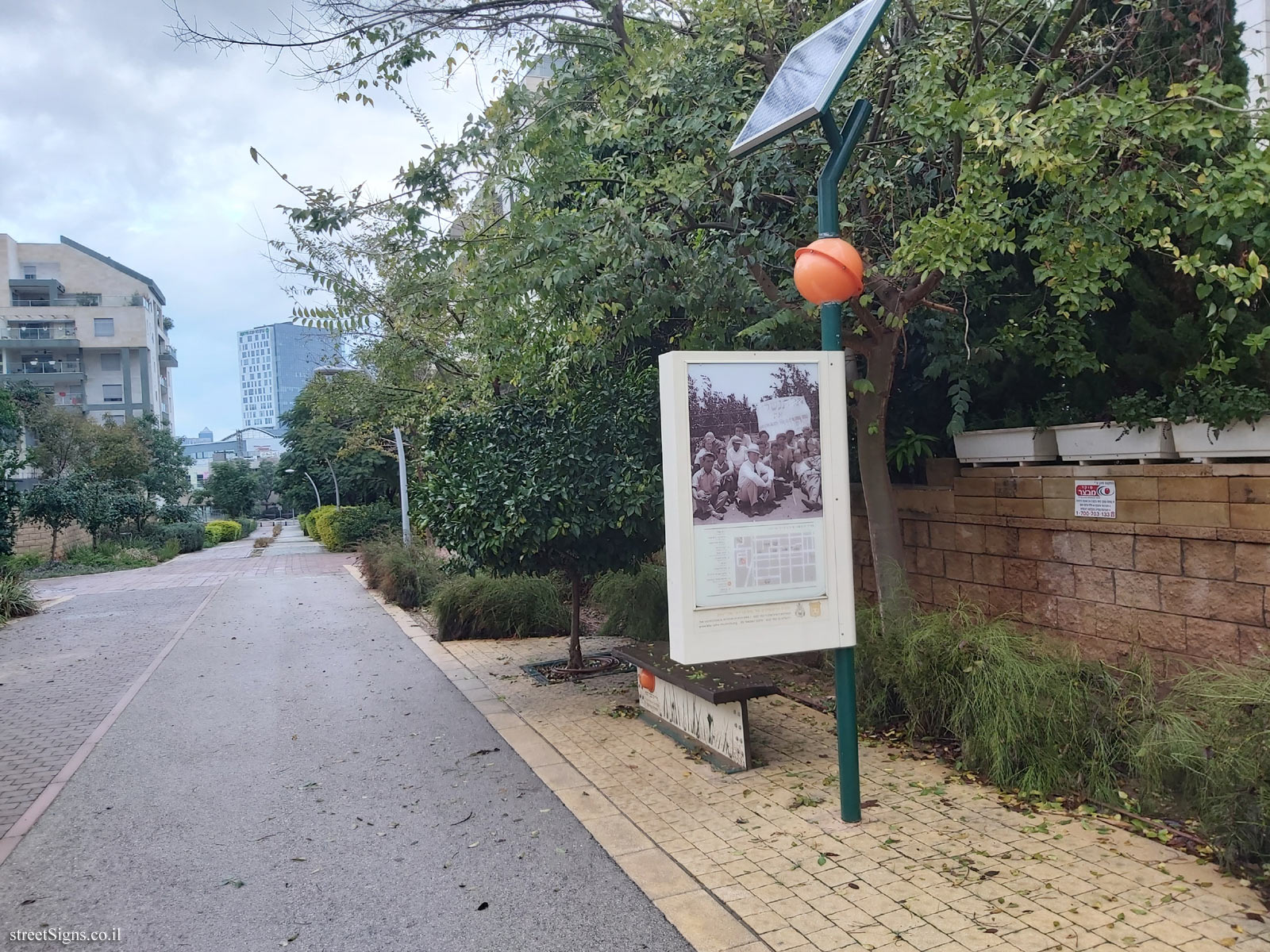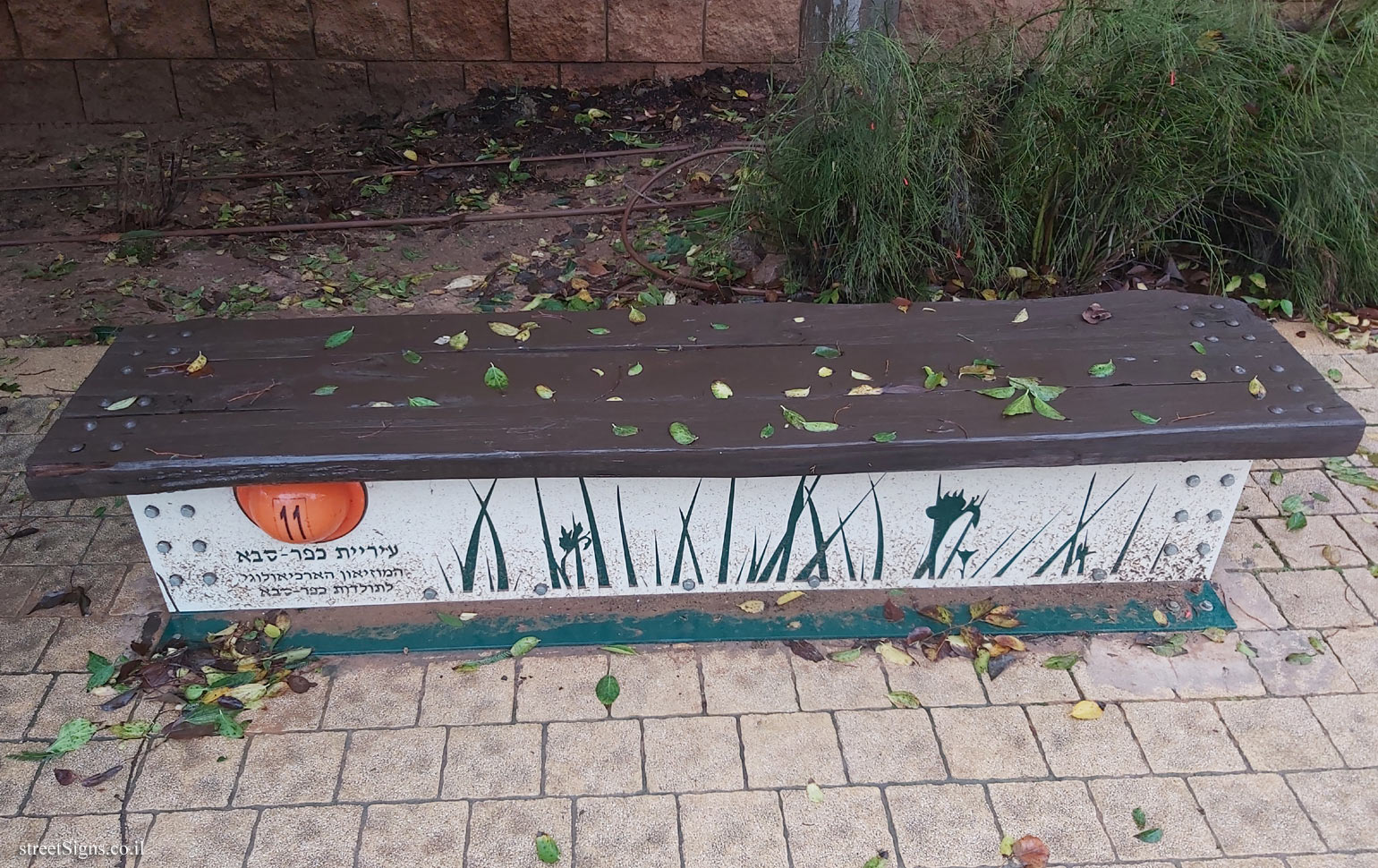On the sign:
[תמונה: משמרת מחאה של פועלים עבריים]
[מפת השביל]
[הצד השני של השלט]
הפרדסנות במושבה
Citrus Growing
במחצית השנייה של שנות העשרים של המאה ה-20, עם התרחבות ענף ההדרים שהחליפו את השקדים, הסתמן שינוי במושבה.
אדמות החול האדום (חמרה) של כפר-סבא נמצאו מתאימות לנטיעת הדרים ועד סוף העשור השני הקיפו פרדסים בשטח של כ-2,000 דונם את המושבה מכל עבריה. כמו במושבות אחרות במישור החוף, הפכו ההדרים בכפר-סבא לענף ראשון במעלה למשך שנים רבות.
במהלך שנות השלושים עברה המושבה, כמו היישוב היהודי כולו, תהליך התפתחות מואץ. בראש הפירמידה הכלכלית והתעסוקתית ניצב בכל אותן שנים ענף ההדרים, שהעסיק בעונת החרוף - ימי הקטיף, האריזה והמשלוח - מאות ואף אלפי עובדים. משקיעים מארצות חוץ ביקשו לרכוש כאן פרדסים ואף לטעת חדשים. במשך שנים אחדות הועסקו בענף רק עובדים יהודים, וכפר-סבא התגאתה, כמו יתר יישובי השרון, ב"עבודה עברית". אולם כשגברה בחורף 1934 הדרישה לכוח-אדם, ופועלים יהודים לא היו בנמצא, נאלצו הפרדסנים להעסיק ערבים, שהיוו כוח עבודה זול. מעשה שגרם לאחד העימותים הקשים בתולדות המושבה והיישוב היהודי כולו, שנמשך שנים אחדות.
הסתדרות העובדים עמדה על כך שעבודות הקטיף והאריזה יבוצעו רק בידי יהודים. האיכרים טענו שאין הם מקבלים די עובדים והעסיקו ערבים. הפועלים היהודים ארגנו משמרות=מחאה בהשתתפות מנהיגים, מורים וסופרים בשערי הפרדסים שהעסיקו ערבים. הדברים הגיעו לידי עימותים והמשטרה הבריטית התערבה ואסרה אחדים ממנהיגי הפועלים.
מכפר-סבא נאסרו ’השלושה מכפר-סבא’, פ’ ספיר, י. בנקובר ור’ שרייבמן, דבר שגרם לסערת רוחות במושבה ועורר הדים ברחבי הארץ.
המתיחות הגואה, ההתנגשויות האלימות, המאסרים והמשפטים גררו בסופו של דבר התערבות תקיפה של ההנהגה הציונית, אשר הביעה תמיכה בנאמנותם של הפועלים.
מאבק הפועלים נכשל אך היה לו ערך חינוכי ניכר והוא הפך למיתוס מקומי.
יְמֵי הַחַמְרָה
יעקב שרייבמן
(פְּרִיחַת הָאָבִיב וּבְשָׂמֶיהַ
בְּשָׁדוֹת אֲחֵרִים וְזָרִים,
הָלְמָה בִּי כְּמוֹ שַַבְתִּי אֵלֵיהָ -
אֶל יָמים רְחוֹקִים, מוּאָרִים...)
הָיָה שָם רֵיחַ פַּרְדֵסִים,
חִיוּךְ צָהֹב שֶל שֶסֶק,
וּוְרֹד גוּאַיָיבָה עֲסִיסִית
נוֹטֵף עַל הַמִרְפֶּסֶת;
וּתְלָמִים אֶל קְצֵה מֶרְחָב,
וּבֵית הַאֲרִיזָה, וּבְרֹוש;
הָיוּ שָם שְבִיל אֶל צֵל בְּרֵכָה,
וּשְׁדֵה הַמַמְטֵרוֹת.
הוֹ, אַדְמַת הַחַמְרָה
רֵיחֵךְ אַחַר מָטָר!
...וְעָנָן הַשָט בַּרוֹם
וְשָט בְּתוֹך שְלוּלִית...
כַּפַוֹת רַגְלַי שֶעוֹד צוֹרְבוֹת
- מִזֵכֵר קַיִץ שֶבָּעַר -
הוֹ, שְׁאוּ אוֹתִי עַכְשָו, הַיוֹם,
אֶל לֵיל הַאֶשְכּוֹלִית!
לא, אֵין כְּבָר רֵיחַ פַּרְדֵסִים,
וְלֹא חִיוּךְ שֶל שֶסֶק,
אֵין וְרֹד גוּאַיָבָה שֶמַצִיץ
בַּסְתָּו אֶל הַמִרְפֶּסֶת.
- מִמְרוֹם חַלוֹן קוֹמָה שִשִית
שוּב לֹא נִשְקָף נוֹף בְּרֵאשִית:
עוֹנוֹת שָנָה, וְעוֹד אַחַת,
בֵּין קִיר בֶּטוֹן וּכְבִיש אַסְפַלְט...
רַק בְּרוֹש בּוֹדֵד עַל גְּבוּל גָּדֵר
- אַחֲרוֹן מִשְמֶרֶת צֵל הַקַיִץ -
עוֹד מַשְקִיף וְעוֹד זוֹכֵר
אוֹתָךְ, אוֹתִי, וְרֵיחַ בַּיִת.
In the second half of the twenties of the 20th century, with the expansion of the citrus industry that replaced the almonds, there were signs of change in the Colony.
Kfar Saba’s red sandy lands (red loam) were found to be suitable for planting citrus trees, and by the end of the decade some 2.000 dunams of orchards surrounded the Colony on all sides. Alike other colonies on the coastal plain, the Kfar Saba citrus fruits became the most important industry for many years.
During the thirties, the Colony, alike the entire Jewish settlement, underwent an accelerated development process. At the top of the economic and employment pyramid throughout all these years was the citrus industry. In the winter season it imployed fruit picking, packing and deliveries - hundreds and even thousands of workers. Investors from foreign countries asked to purchase orchards here, and even to plant new ones. For several years the industry only employed Jewish workers and Kfar Saba was proud, along with the rest of the Sharon settlements, of its "Jewish labour". However when in the winter of 1934 the requirement for manpower increased, Jewish workers could not be found. The orchard owners were forced to employ Arabs, which constituted an inexpensive work force. This act caused one of the most severe confrontations in the history of the Colony and the entire Jewish settlement, which continued for several years.
The Workers Union insisted that fruit picking and packing works would be carried out only by Jews. The farmers claimed that they were not receiving sufficient workers and employed Arabs. The Jewish workers organized protest shifts with the participation of leaders, teachers and authors, at the gates of the orchards which employed Arabs. Matters reached confrontations and the British Police intervened and arrested several of the active leaders.
From Kfar Saba "the Kfar Saba Three" were arrested: P. Sapir, Y Bankover and R. Shreibman, which caused flared tempers in the Colony and evoked reverberations throughout the country. The rising tensions, the violent clashes, the arrests and the trials caused, at the end of the day, the aggressive intervention of the Zionist leadership, which expressed support for, the loyalty of the workers. The workers struggle failed. However, it had a significant educational value and became a local legend.
סמל העיר כפר סבא
סמל מוזיאון כפר סבא
שביל הראשונים על שם מרדכי שרייבמן
המוזיאון הארכיאולוגי כפר-סבא
ירושלים 35 כפר-סבא
טלפון 09.7640867
THE ARCHAEOLOGICAL MUSEUM OF KFAR-SABA
www.kfar-saba-museum.org

 Click for a larger image
Click for a larger image  Click for a larger image
Click for a larger image  Click for a larger image
Click for a larger image  Click for sign's details
Click for sign's details